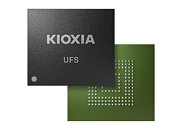Wednesday, January 19th 2022

Kioxia Advances Development of UFS Ver. 3.1 Embedded Flash Memory Devices With Quad-level-cell (QLC)
Kioxia Corporation, a world leader in memory solutions, today announced the launch of Universal Flash Storage (UFS) Ver. 3.1 [1] embedded flash memory devices utilizing the company's innovative 4-bit per cell quad-level-cell (QLC) technology. For applications needing high density, such as cutting-edge smartphones, Kioxia's QLC technology enables the capability to achieve the highest densities available in a single package.
Kioxia's UFS proof of concept (PoC) device is a 512 gigabyte prototype that utilizes the company's 1 terabit (128 gigabyte) BiCS FLASH 3D flash memory with QLC technology, and is now sampling to OEM customers. The PoC device is designed to meet the increasing performance and density requirements of mobile applications driven by higher resolution images, 5G networks, 4K plus video and the like.The samples are POC devices under development and have some feature limitations. Furthermore, specifications of the devices are subject to change without prior notice.
In every mention of a Kioxia product: Product density is identified based on the density of memory chip(s) within the Product, not the amount of memory capacity available for data storage by the end user. Consumer-usable capacity will be less due to overhead data areas, formatting, bad blocks, and other constraints, and may also vary based on the host device and application. For details, please refer to applicable product specifications.
All company names, product names and service names may be trademarks of their respective companies.
Kioxia's UFS proof of concept (PoC) device is a 512 gigabyte prototype that utilizes the company's 1 terabit (128 gigabyte) BiCS FLASH 3D flash memory with QLC technology, and is now sampling to OEM customers. The PoC device is designed to meet the increasing performance and density requirements of mobile applications driven by higher resolution images, 5G networks, 4K plus video and the like.The samples are POC devices under development and have some feature limitations. Furthermore, specifications of the devices are subject to change without prior notice.
In every mention of a Kioxia product: Product density is identified based on the density of memory chip(s) within the Product, not the amount of memory capacity available for data storage by the end user. Consumer-usable capacity will be less due to overhead data areas, formatting, bad blocks, and other constraints, and may also vary based on the host device and application. For details, please refer to applicable product specifications.
All company names, product names and service names may be trademarks of their respective companies.

6 Comments on Kioxia Advances Development of UFS Ver. 3.1 Embedded Flash Memory Devices With Quad-level-cell (QLC)
QLC should not be a problem in a mobile device.
If they can produce loads of it at a good price maybe we'll finally be rid of eMMC which should have left the scene long ago